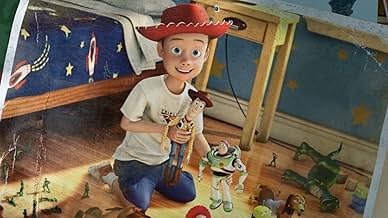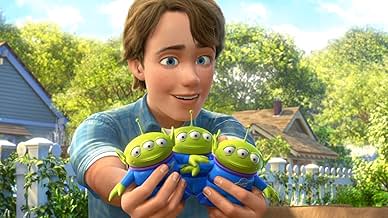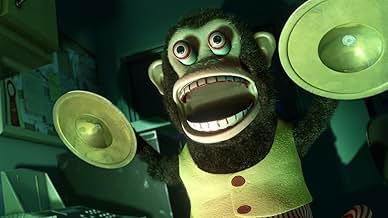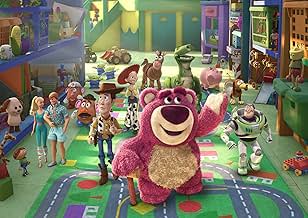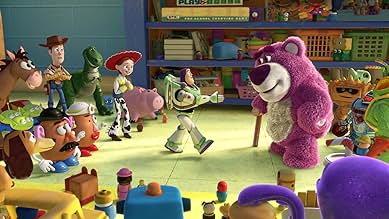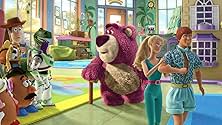I giocattoli vengono erroneamente consegnati ad un centro diurno invece che nell'attico prima che Andy parte per il college, e tocca a Woody convincere gli altri giocattoli che non sono stat... Leggi tuttoI giocattoli vengono erroneamente consegnati ad un centro diurno invece che nell'attico prima che Andy parte per il college, e tocca a Woody convincere gli altri giocattoli che non sono stati abbandonati e tornare a casa.I giocattoli vengono erroneamente consegnati ad un centro diurno invece che nell'attico prima che Andy parte per il college, e tocca a Woody convincere gli altri giocattoli che non sono stati abbandonati e tornare a casa.
- Vincitore di 2 Oscar
- 63 vittorie e 96 candidature totali
Tim Allen
- Buzz Lightyear
- (voce)
Joan Cusack
- Jessie
- (voce)
Ned Beatty
- Lotso
- (voce)
Michael Keaton
- Ken
- (voce)
Wallace Shawn
- Rex
- (voce)
John Ratzenberger
- Hamm
- (voce)
John Morris
- Andy
- (voce)
Jodi Benson
- Barbie
- (voce)
Emily Ricks Hahn
- Bonnie
- (voce)
- (as Emily Hahn)
Laurie Metcalf
- Andy's Mom
- (voce)
Blake Clark
- Slinky Dog
- (voce)
Bud Luckey
- Chuckles
- (voce)
Bea Miller
- Molly
- (voce)
- (as Beatrice Miller)
Trama
Lo sapevi?
- QuizA stuffed bear resembling Lotso can be seen in Toy Story - Il mondo dei giocattoli (1995) during the staff meeting. Woody asks if the toys "up on the shelf can hear" him, and we see a shot of a big, pinkish bear. John Lasseter wanted to use Lotso in the original Toy Story, but Pixar had trouble getting the fur right.
- BlooperWhen the toys are close to the industrial shredder, Slinky Dog is first pulled to the ceiling. Realizing the pull is due to a magnet the other toys grab metal objects to get pulled up and escape the shredder. On the other side of the shredder, the toys release the metal objects and fall back to the conveyor belt, inexplicably Slinky is there with them and the magnet seems to no longer affect him.
- Curiosità sui creditiDuring the beginning of the ending credits, it is shown what becomes of Sunnyside and Andy's toys. Jessie turns on a Spanish version of "You've a Friend in Me" and dances a paso doble with Buzz.
- Versioni alternativeThe South African version features Jeremy Mansfield (a well-known radio personality) as the voice of Chatter Phone.
- ConnessioniEdited from Plan 9 from Outer Space (1957)
Recensione in evidenza
Is there Life after playtime? Can you handle a film in which the toys are playing with us, the audience? The third chapter of the Toy Story saga asks some tough questions of viewers, but the rewards of seeing this remarkable film outweigh the emotional toll.
It's the last week of summer before Andy heads off to college, and Woody (Tom Hanks) and the other remaining toys in Andy's bedroom find themselves in fear of what's to become of them. It looks like the attic, but events conspire to throw them a day-care center called Sunnyside. It looks swell enough, at first...
"You'll never be outgrown, or neglected," the toys are informed by the chuckily plush play bear Lots-O (Ned Beatty). "Never abandoned or forgotten. No owners means - no heartbreak!"
It's odd to see a film series that started out as an animated lark turn into "Watership Down", but there's always been some existential angst at the heart of the enterprise, c.f. the fragile buddy system employed in the first "Toy Story", Sid's hapless victims, and talk of rummage sales. The second film pushed these buttons a bit harder, to the point of losing the humor.
This time the drama is stronger than ever, yet the film amazingly manages to stay refreshingly clever and hilarious. We meet Ken (Michael Keaton), who introduces himself to Barbie saying "We were made for each other". Ken must deal with wisecracks about being a girl's toy, or as Mr. Potato Head (Don Rickles) puts it, "an accessory, a purse with legs." The daycare center is also fabulously realized, a cacophony of misfit toys all showing signs of wear from constant play. Every now and again we break away to see Woody in his new situation, being played with by a girl named Bonnie who is very nice but has a left-field imagination. "We do a lot of improv here," another toy tells him.
All this is very funny, and director Lee Unkrich and the Pixar writers and artists find brilliant ways to keep humor close to the center of things throughout. Yet this movie is no lark. One of the funniest scenes the first time I saw this movie three weeks ago, involving a cutaway to a clown staring at a window, got hardly a laugh when I saw it again tonight. I think it was because the rest of the audience, like me, knew what was coming; a sad story about cosmic indifference and cold-hearted abandonment which sets in motion the real emotional undertow of the film.
Set against this is Woody's firm if shaken resolution to "be there for Andy", even when it seems he and the other toys are no longer wanted by their owner. It's a message of faith you relate to, yet it also brings out another point, the notion of change, even painful change, as needful. The toys know they'll be neglected, perhaps forever, if exiled to the attic, but prefer it to the unknown. This actually makes sense. What can happen out there isn't very nice, but even in the face of extinction the film suggests a certain nobility through acceptance can be still possible. It's a pretty heavy message to take away from watching a G-rated comedy.
The film doesn't leave you on a down note, but it's a funny thing. In the past, I always looked forward to the post-credit goof scenes as something to laugh at on my way out of the theater. This time, I appreciated it just as much as a chance to wipe my eyes before I got out of my chair. It still felt good, though.
It's the last week of summer before Andy heads off to college, and Woody (Tom Hanks) and the other remaining toys in Andy's bedroom find themselves in fear of what's to become of them. It looks like the attic, but events conspire to throw them a day-care center called Sunnyside. It looks swell enough, at first...
"You'll never be outgrown, or neglected," the toys are informed by the chuckily plush play bear Lots-O (Ned Beatty). "Never abandoned or forgotten. No owners means - no heartbreak!"
It's odd to see a film series that started out as an animated lark turn into "Watership Down", but there's always been some existential angst at the heart of the enterprise, c.f. the fragile buddy system employed in the first "Toy Story", Sid's hapless victims, and talk of rummage sales. The second film pushed these buttons a bit harder, to the point of losing the humor.
This time the drama is stronger than ever, yet the film amazingly manages to stay refreshingly clever and hilarious. We meet Ken (Michael Keaton), who introduces himself to Barbie saying "We were made for each other". Ken must deal with wisecracks about being a girl's toy, or as Mr. Potato Head (Don Rickles) puts it, "an accessory, a purse with legs." The daycare center is also fabulously realized, a cacophony of misfit toys all showing signs of wear from constant play. Every now and again we break away to see Woody in his new situation, being played with by a girl named Bonnie who is very nice but has a left-field imagination. "We do a lot of improv here," another toy tells him.
All this is very funny, and director Lee Unkrich and the Pixar writers and artists find brilliant ways to keep humor close to the center of things throughout. Yet this movie is no lark. One of the funniest scenes the first time I saw this movie three weeks ago, involving a cutaway to a clown staring at a window, got hardly a laugh when I saw it again tonight. I think it was because the rest of the audience, like me, knew what was coming; a sad story about cosmic indifference and cold-hearted abandonment which sets in motion the real emotional undertow of the film.
Set against this is Woody's firm if shaken resolution to "be there for Andy", even when it seems he and the other toys are no longer wanted by their owner. It's a message of faith you relate to, yet it also brings out another point, the notion of change, even painful change, as needful. The toys know they'll be neglected, perhaps forever, if exiled to the attic, but prefer it to the unknown. This actually makes sense. What can happen out there isn't very nice, but even in the face of extinction the film suggests a certain nobility through acceptance can be still possible. It's a pretty heavy message to take away from watching a G-rated comedy.
The film doesn't leave you on a down note, but it's a funny thing. In the past, I always looked forward to the post-credit goof scenes as something to laugh at on my way out of the theater. This time, I appreciated it just as much as a chance to wipe my eyes before I got out of my chair. It still felt good, though.
I più visti
Accedi per valutare e creare un elenco di titoli salvati per ottenere consigli personalizzati
Dettagli
- Data di uscita
- Paese di origine
- Siti ufficiali
- Lingue
- Celebre anche come
- Toy Story 3
- Luoghi delle riprese
- Aziende produttrici
- Vedi altri crediti dell’azienda su IMDbPro
Botteghino
- Budget
- 200.000.000 USD (previsto)
- Lordo Stati Uniti e Canada
- 415.004.880 USD
- Fine settimana di apertura Stati Uniti e Canada
- 110.307.189 USD
- 20 giu 2010
- Lordo in tutto il mondo
- 1.067.316.101 USD
- Tempo di esecuzione1 ora 43 minuti
- Colore
- Mix di suoni
- Proporzioni
- 1.78 : 1(original & intended ratio, Blu-ray)
Contribuisci a questa pagina
Suggerisci una modifica o aggiungi i contenuti mancanti







